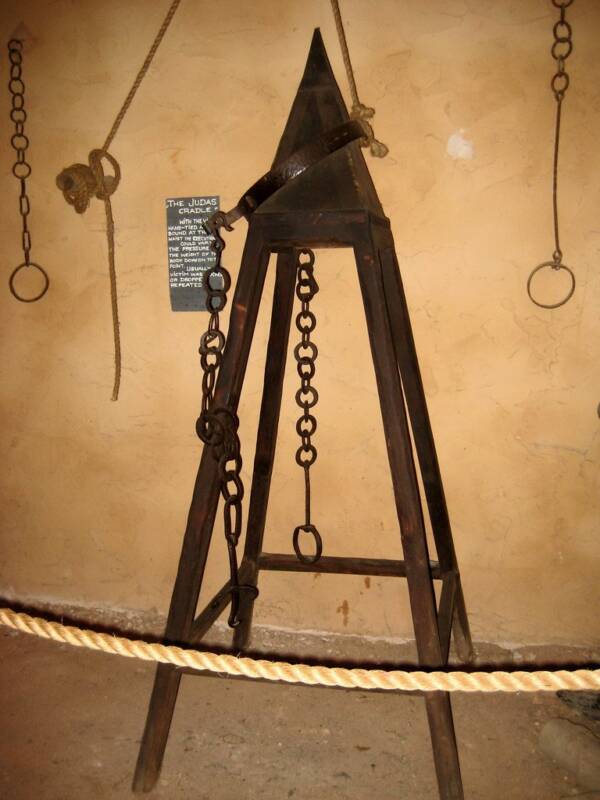While it may not look like much, the Judas cradle is believed to have spelled a sickening end for the heretics who ended up on the wrong side of its razor-sharp tip during the Spanish Inquisition.

The Judas Cradle, a medieval form of torture employed during the Spanish Inquisition.
If there’s one thing that we can expect from the Spanish Inquisition, it’s unique and brutal methods of torture.
In fact, some of history’s most infamous torture methods were implemented by the inquisitors to punish those believed to have sinned, including the rack, the wheel, and water torture. One lesser known torture method favored by the Spanish, though, was the Judas Cradle — and oddly, they considered it to be one of the most humane.
There’s not much to the device itself. It’s a carved wooden pyramid at the top of three wooden legs, sort of like a stool though admittedly not one you’d want to sit on. It was placed in the corner of a torture chamber, and above it a person would be suspended, nude, with their hands and feet bound by ropes attached to gears.
They would then be slowly lowered onto the tip of the Judas Cradle, sometimes with additional weights, until it ripped through their pelvis.
Hippolytus De Marsiliis, The Architect Of The Judas Cradle
Someone, of course, had to conceive of the Judas Cradle, and though much credit is paid to the Spanish Inquisition for incorporating it, it was originally the idea of an Italian lawyer named Hippolytus De Marsiliis, or Ippolito Marsili. Marsili also, notably, was the man responsible for introducing water torture to the world.
Marsili studied law in Bologna with other notable figures such as Andrea Barbazza, Vincenzo Paleotti, and Alberto Cattani, later becoming the favorite pupil of Felino Sandeo, who held the chair of canon law in Ferrara and Pisa for a time.

Culture Club/Getty ImagesMedieval water torture, usually done to women who the church felt were weaker than men and would give up with a “lesser” form of torture.
Marsili himself received a doctorate in utroque iure (a doctor of both civil and church law) in 1480, and two years later obtained a chair of civil law, and later becoming a mentor to Antonio Burgos and Paolo d’Oria. Throughout his career, Marsili had numerous students and gave countless lectures, many of which he chronicled in print as well.
But Marsili is perhaps best known for the various torture methods he devised. Many judges of his era had, as it turned out, a propensity for torture, and though Marsili viewed it only as a necessary evil, rather than entertainment, his mind produced some of the most abhorrent techniques for torture.
Alongside water torture — devised by simply witnessing water erode parts of stone — Marsili also came up with the discipline of forced vigil. This technique saw the prisoner being seated in a chair and observed by torturers who forced them to remain awake. Sometimes, this meant forcing a prisoner to stay up for 40 hours straight.
Marsili, of course, also came up with the Judas Cradle. As for why or how, well, records don’t exactly make it known. Presumably, Marsili and others versed in church law spent a lot of time thinking of torture techniques, and the Judas Cradle was just one result of that.

The Print Collector/Print Collector/Getty ImagesThe “question extraordinaire,” an extreme form of torture similar to the Judas Cradle and the Spanish Donkey.
Marsili also considered many of his torture techniques to be humane, simply for the fact that they didn’t involve burning someone’s flesh or breaking their bones. Even the Judas Cradle was only intended to keep a person awake and sleep deprived — but torturers found a way to tear through a person anyway.
It didn’t help, either, that they rarely cleaned the wooden pyramids, leading many prisoners to die of infection on account of the dried blood and feces.
Torture Techniques Employed By The Spanish Inquisition
Around the time Marsili was thinking up his “humane” torture techniques, other members of the church in Spain were busy employing the many, many torture methods they had picked up over the years. Supposedly, torture was done to root out heretics, with the end goal being the spread and domination of Catholicism across the country.

Historical Picture Archive/CORBIS/Corbis via Getty ImagesAnother form of torture that the Inquisition enjoyed: The victim is suspended in the air, with weights attached to their body, dislocating his spine and eventually breaking it.
That said, there weren’t exactly many ground rules for the inquisitors, meaning they were pretty much free to “extract information” whenever and however they pleased. In fact, the Grand Inquisitor, Tomás de Torquemada, rose through the ranks because of his cruelty — and later wielded his power to expel more than 160,000 Jews from Spain.
On top of that, any Jews or Muslims who remained and converted were immediately targeted by Torquemada and his inquisitors, most of whom felt that the converts had not aligned with Christianity for the right reasons. Rather, he felt (perhaps correctly) that many had only converted out of fear of death.
And though Torquemada was among the most heinous of inquisitors — personally overseeing 2,000 executions in his time — he was hardly the only one to dish out harsh punishments to alleged heretics.

Three Lions/Getty Images1520: The Spanish Inquisition torturing suspected Protestants and “insincere” Christians in a torture chamber.
Per the Encyclopedia Britannica, the Inquisition continued to drive out, hunt down, condemn, and kill well into the mid-18th century, still employing Torquemada’s favorite punishment, the auto-da-fé, or “act of faith.” Essentially, this just meant burning someone at the stake to force them to confess their sins. Needless to say, most people didn’t survive, even if they did confess.
Alongside this, however, the Spanish inquisitors regularly employed other cruel tortures, including the Spanish Donkey, the Rack, the Knee Splitter, and of course the Judas Cradle — named appropriately for the original heretic, in the eyes of the church.
The Judas Cradle At The Museum Of Torture
Of course, like many other ancient torture devices, visitors to the Torture Museum can see for themselves what a Judas Cradle looks like in person. In fact, they have two different models on display: one that looks like a small pyramid affixed to four angled legs in each of its corners, and another where the pyramid sits atop a spike, almost like an arrow, atop four legs.

TwitterOne version of the Judas Cradle on display.
Their website also features a “fiction description” of what this torture technique entailed:
“The heart-piercing cry makes even the executioners wince. The edges bite into the crotch of this soon-to-be Judas, tearing tendons, nerves, and lymph nodes… A mixture of blood and feces streams down along the faces of the pyramid. Most of those sentenced give up within a few minutes, maximum…”
The Judas Cradle is undoubtedly one of the most punishing torture methods in history — and yet, it was considered relatively humane in its day.
After this look at the Judas Cradle, read about the stomach-turning history of rat torture. Then, learn about the Viking’s Blood Eagle, a torture method so cruel that some historians question its very existence.





